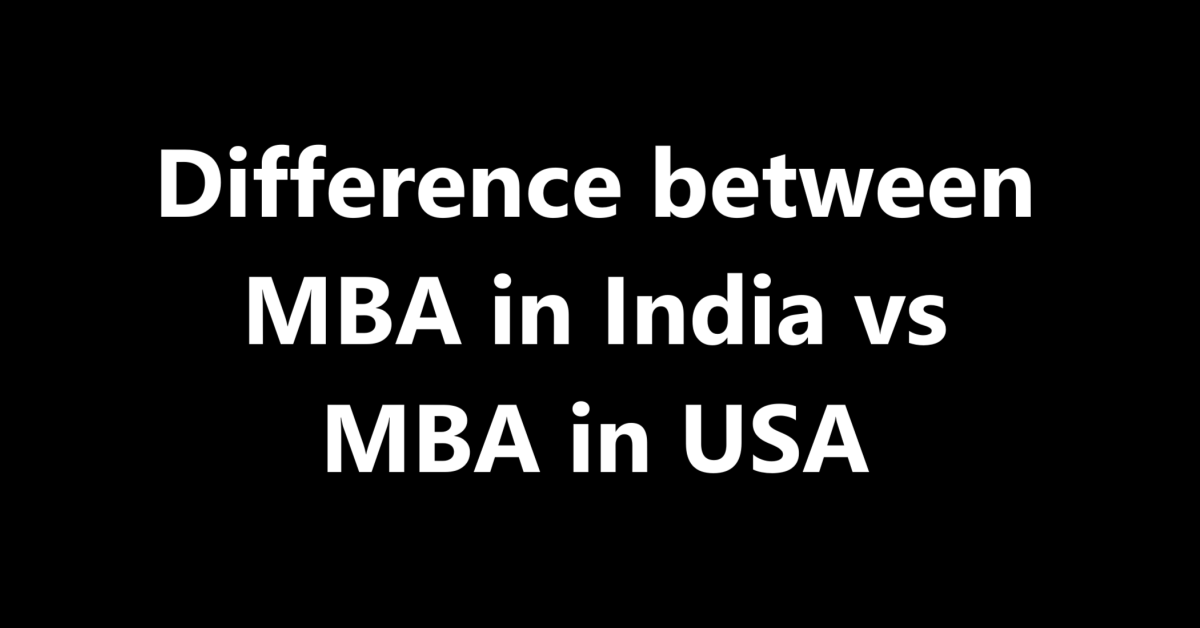Pursuing an MBA is a significant decision, and the experience can vary greatly between different countries. Here’s a comparison of pursuing an MBA in India versus the USA, highlighting key differences across various aspects.
1. Program Duration
- India:
- Typically, an MBA program lasts 2 years (4 semesters) for full-time courses, though some institutes offer one-year executive programs for experienced professionals.
- USA:
- MBA programs generally last 2 years for full-time programs, with many schools offering a 1-year accelerated option for those who have prior business education or experience.
2. Curriculum and Specializations
- India:
- The curriculum is often more theoretical with a focus on core subjects such as Marketing, Finance, HR, and Operations. Specializations may be introduced in the second year.
- Internships are encouraged but may not be mandatory.
- USA:
- The MBA curriculum tends to be more practical and case-study-driven, with a strong emphasis on critical thinking and real-world applications.
- Many programs offer electives from the first semester, allowing for early specialization.
- Internships, especially summer internships, are often critical for job placements post-MBA.
3. Admission Requirements
- India:
- Admissions usually require candidates to take entrance exams such as the CAT (Common Admission Test), MAT (Management Aptitude Test), or other university-specific tests.
- Strong academic performance in undergraduate studies is essential.
- USA:
- Admission requires taking the GMAT (Graduate Management Admission Test) or GRE (Graduate Record Examination).
- A holistic review process is common, considering work experience, recommendation letters, personal essays, and interviews.
4. Cost and Financial Aid
- India:
- MBA programs can range from ₹5 lakh to ₹25 lakh or more, depending on the institution. Public institutions are generally less expensive than private ones.
- Financial aid and scholarships are less common.
- USA:
- Tuition fees range from $30,000 to over $100,000 for two years. Life expenses can also significantly increase the total cost.
- A variety of scholarships, assistantships, and loans are available to help finance education.
5. Cultural and Learning Environment
- India:
- An MBA in India often includes a mix of traditional classroom learning and group projects, with a focus on local business practices.
- The student population tends to be more homogeneous.
- USA:
- MBA programs in the USA are diverse, attracting international students and providing a rich multicultural environment.
- Class discussions, teamwork, and networking are heavily emphasized.
6. Job Opportunities and Placement
- India:
- Job placements after graduation depend significantly on the institution’s reputation and network. High-demand sectors include IT, consulting, and finance.
- The job market is competitive, and salary ranges can vary widely.
- USA:
- MBA graduates often find robust job opportunities in diverse industries, with many top companies actively recruiting from campuses.
- Starting salaries for MBA graduates in the USA can be considerably higher, often ranging from $70,000 to over $120,000.
7. Networking Opportunities
- India:
- Networking happens through alumni relations and industry interactions, but the scale may be limited compared to international standards.
- Local industry connections play a significant role in placement.
- USA:
- American MBA programs offer extensive networking opportunities, often with opportunities to connect with various industry leaders, alumni, and peers through events, internships, and projects.
FAQs on the Differences Between MBA in India and MBA in the USA
Here are some frequently asked questions (FAQs) regarding the differences between pursuing an MBA in India and an MBA in the USA, along with concise answers:
1. What is the typical duration of an MBA program in India and the USA?
- India: Most full-time MBA programs last 2 years.
- USA: Full-time programs typically last 2 years, with some accelerated options available for 1 year.
2. What are the admission requirements for MBA programs in India and the USA?
- India: Admission usually requires entrance exams like CAT or MAT, along with a strong academic record.
- USA: Admissions typically require the GMAT or GRE, along with a holistic review of work experience, recommendation letters, and personal essays.
3. How do the curriculums differ between MBA programs in India and the USA?
- India: The curriculum often focuses on core subjects with theoretical learning and may introduce specializations in the second year.
- USA: The curriculum is usually more practical, emphasizing case studies and offering electives from the first semester.
4. What is the cost difference for an MBA in India versus the USA?
- India: Tuition fees generally range from ₹5 lakh to ₹25 lakh, depending on the institution.
- USA: Tuition can vary widely, ranging from $30,000 to over $100,000 for two years, with additional living expenses.
5. What are the job prospects like after completing an MBA in India compared to the USA?
- India: Job placements can be competitive, depending largely on the institution’s reputation and local industry demand.
- USA: There are often robust job opportunities with many companies actively recruiting from campuses, and starting salaries can be considerably higher.
6. How important are internships in these MBA programs?
- India: Internships are encouraged but may not be mandatory for all programs.
- USA: Internships, especially summer internships, are critical for job placements post-MBA and are often required.
7. What is the cultural and educational environment difference between the two countries?
- India: The educational environment often focuses on local business practices and has a more homogeneous student population.
- USA: The learning environment is diverse and multicultural, emphasizing teamwork and networking.
8. Are financial aid and scholarships more available in the USA or India?
- India: Financial aid and scholarship options are typically less common.
- USA: There are various scholarships, assistantships, and loan options available to help finance education.
9. How do networking opportunities compare between the two countries?
- India: Networking primarily occurs through alumni and industry interactions, with a focus on local connections.
- USA: Programs offer extensive networking opportunities with industry leaders, alumni, and peers through events, internships, and collaborative projects.
10. Which MBA is generally considered more valuable globally?
- India: An MBA from a top-tier Indian institution is well-respected, especially in the local market and for positions in Asia.
- USA: An MBA from a globally recognized US institution can carry significant weight worldwide and often opens doors to international job markets.
Conclusion
Choosing between pursuing an MBA in India or the USA depends on your individual goals, financial considerations, and career aspirations. Each has its strengths and can provide valuable experiences and opportunities.


